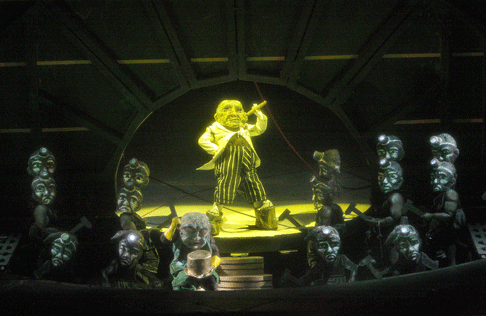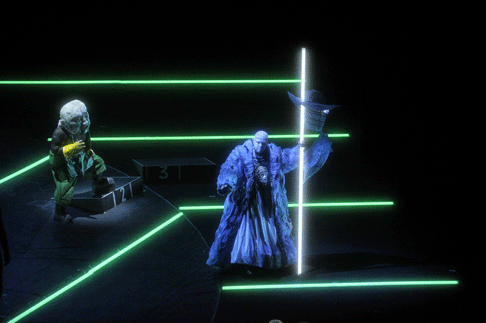21 Jun 2010
Der Ring des Nibelungen in Los Angeles
$32,000,000, and it would have been a bargain at $50,000,000. Los Angeles Opera went for broke, and it paid off with a Ring that has raised the worldwide Ring bar to a dizzying height.

$32,000,000, and it would have been a bargain at $50,000,000. Los Angeles Opera went for broke, and it paid off with a Ring that has raised the worldwide Ring bar to a dizzying height.
It was everything smart money can buy. L.A. superseded the sometimes sleazy flash of its film and television industry with brilliant flash, reminding us that this huge center of intellectual property is driven by artistic creation. There was no compromise. The nine day duration made it possible to retain the same Wotan, Brünnhilde and Siegfried et al. and to keep them in good voice, and it gave pilgrims to the L.A. Ring ample time to explore this magnificent city of art, architecture, gardens and music.
This Ring was indeed flashy, starting in the pit. Conductor James Conlon did not explore or even approach the cosmic sonorities of Wagner’s score choosing to propel text and musical line to their maximum tension, nearly unbearable in Wotan’s farewell to Brünnhilde (arms outstretched they passed without touching). He choose the brightest voices to enflame the Valkyries ride (though actually they just stood there), he unveiled the love of Siegfried and Brünnhilde with such urgency (though they stood on opposite sides of the stage) that it became vocally extremely dangerous — and breathtakingly exciting.
But the immolation was delivered by a Brünnhilde (facing the audience standing on a center stage podium) who was wise and resigned rather than ecstatic, and finally Mo. Conlon’s cataclysm was measured rather than unleashed. At the end Wagner’s resolution was not a hopeful return to a primal world but the sad, unlamented demise of tormented creatures. Operatic indeed, and heartbreaking too.
Though Mo. Conlon was perhaps limited by the L.A. Opera orchestra itself, his path was shared if not proscribed by line and color, by masks, puppets and symbols.
German artist Achim Freyer got the gigantic commission to create this staging of Richard Wagner’s treatise, a fancy that incorporates the nineteenth century bourgeois social conscience with opera’s age old tensions — love, jealousy and dirty politics. Just as much about all this old operatic stuff Wagner’s treatise is about art — the building of Valhalla and the forging of the ring. So Mr. Freyer made his own art the focal point of his Ring.
Achim Freyer’s art is visual and for Freyer music is equally visual. Music must flow therefore Freyer’s art too must flow. The static frames that are formed on the stage by Freyer’s masks and puppets are overlaid with constant movement. Sometimes by horizontal or vertical lines that traverse the stage’s fourth wall (the proscenium opening), sometimes by a gigantic stage floor disk that revolves, other times by huge cloths pulled across the stage. With Brünnhilde deprived of her divinity black human forms began to slowly traverse the stage in perpetual pacing. Freyer’s catalogue of flow was inexhaustible.
As the music of Germany’s great river flows from the Ring’s inception to beyond its end, Wagner’s music flows too for the Ring’s twenty or so hours (intermissions included) and so flows Freyer’s visual world for these eternal hours, an accomplishment as superhuman as Wotan’s building of Valhalla.
The architecture of the Ring world transformed the Dorothy Chandler Pavilion’s stage. A theater wide scrim was suspended halfway out over the orchestra pit, thereby incorporating much of the orchestra within the volume of the stage. The huge revolving disk was cantilevered far over the pit, platforms suspended on either side of the protruding disk held threatening batteries of lighting instruments. A huge, rather severe rake (sloping platform) covered the stage itself non plussing Siegfried tenor John Treleaven who tripped only a couple of times (second cycle), having warned the world through the L.A. Times that Mr. Freyer’s Ring was a dangerous place.
 Rheingold — Richard Paul Fink as Alberich
Rheingold — Richard Paul Fink as Alberich
The Freyer Ring is a dangerous and exciting space, it’s weapons (the sword and the staff) were tubes of light, its repose was long lines of light, its disorder these long lines broken into a myriad of small lines. The ultimate destruction of the space was effected by the racks of lights hidden in the flys (the space above the stage housing scenery and equipment) suddenly descending with blinding white light, Wotan’s ravens flying out to reveal two onstage conductors (prompters), the upstage scrim disappearing to reveal the bare stage back wall against which all creation flew every which way in black silhouette.
The world of art was destroyed at the same moment our own world was revealed as that same imaginary world. It could be depressing but instead it was thrilling art.
A Valhalla of theatrical art Freyer’s Ring had its Nibelheim as well. A small army (twelve) of silent slaves, Freyer’s Nibelungen, effected the huge puppets who doubled the Ring’s pantheon of characters in defining moments, trudged endlessly across the stage in black body stockings, donned elaborate Nibelungen attire, were rigged to fly above the stage, and the list goes one. It was endless, mindless, thankless labor.
Freyer’s singers, a veritable Who’s Who among opera singers, were but symbols in a gigantic visual world well beyond an opera stage, their faces were masked or painted, their bodies clothed in huge costume caricatures, Brünnhilde magnificent in a huge black wig that would shame Louis XIV. This camouflage left these artists naked as singers, and a vocally more brilliant cast cannot be imagined, down to the last Valkyrie.
 Siegfried — Graham Clark as Mime, Vitalij Kowajow as Wanderer
Siegfried — Graham Clark as Mime, Vitalij Kowajow as Wanderer
Los Angeles itself seems a Valhalla. Traversing this heroic city on its endless Wilshire Boulevard, from the Music Center downtown through Koreatown, then MacArthur Park through Hancock Park stopping at Ace Gallery in Miracle Mile to see the paintings created by Achim Freyer while he was preparing the Ring (priced from $25,000 to $100,000) — canvases that are huge moments of soundless music. Offered too are the prototypes of Wotan’s ravens ($7500 each), and a huge Wotan puppet, the only work in the exhibition that includes sound — piano doodling on Ring themes ($50,000).
Continuing through Beverly Hills and Westwood finally Santa Monica appears and the Ruth Bachofner Gallery at Bergamot Station where L.A. Opera photographer Monika Ritterhaus exhibits her photographs of the Ring production. These stunning mementos of this great theater art were printed (by “art ink jet” onto silver rag) and shimmer in vibrant color (priced from $2500 to $5000). They may be previewed at www.RuthBachofnerGallery.com.
For in depth reviews of the individual operas please consult Opera Today (search title and city) and music critic Mark Swed at LATimes.com.
Michael Milenski